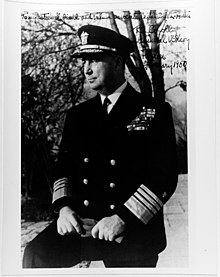Richard L. Conolly
| Richard Lansing Conolly | |
|---|---|

Richard L. Conolly, photographed as a vice admiral
|
|
| Born |
April 26, 1892 Waukegan, Illinois |
| Died | March 1, 1962 (aged 69) Jamaica Bay, New York City, New York |
| Place of burial | Arlington National Cemetery |
| Allegiance |
|
| Service/branch |
|
| Years of service | 1914–1953 |
| Rank |
|
| Battles/wars |
World War I World War II |
| Awards | Navy Cross |
| Other work | President of Long Island University |
Richard Lansing Conolly (April 26, 1892 – March 1, 1962) was a United States Navy Admiral, who served during World War I and World War II.
Conolly was born in Waukegan, Illinois, attended Lake Forest Academy and was appointed to the United States Naval Academy, Annapolis, graduating in 1914. He was assigned to the battleship Virginia (BB-13) and served in Mexican waters. Between May–November 1915 he received training aboard Montana (ACR-13), and in March 1916 he was assigned to Vermont (BB-20) as Torpedo Officer.
Transferred in May 1916 to the destroyer Smith (DD-17), he was aboard her when the United States entered World War I in April 1917. Smith performed escort duty in European waters out of Brest, France.
Conolly was awarded the Navy Cross for his actions in connection with the salvaging of the transport ship USS West Bridge, which was hit by two torpedoes launched by the German submarine U-107 in August 1918. Conolly, with a party of eight others remained on board the badly damaged ship for five days, steering by hand and handling the lines from the tugs, while the ship was towed 400 nautical miles (740 km) to port.
He returned to the United States in November 1918, fitting out, and serving as Executive Officer of the destroyers Foote (DD-169), Worden (DD-288) and Hunt (DD-194) in turn. From August 1920 he studied electrical engineering at Annapolis and Columbia University, New York, receiving a Master of Science degree in June 1922. He then served aboard Mississippi (BB-41), transferring to New York (BB-34) in March 1924 to serve as assistant Engineer Officer until September 1925. He then returned to Annapolis, this time as an instructor in the Department of Electrical Engineering and Physics.
...
Wikipedia
